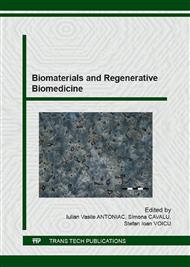[1]
He Y, Zhang ZY, Zhu HG, Qiu W, Jiang X, Guo W, Experimental study on reconstruction of segmental mandible defects using tissue engineered bone combined bone marrow stromal cells with three dimensional tricalcium phosphate, J Craniofac Surg. 18(2007).
DOI: 10.1097/scs.0b013e31806901f5
Google Scholar
[2]
Davo R, Malevez C, Rojas J, Immediate function in the atrophic maxilla using zygoma implants: a preliminary study, J Prosthet Dent. 97(2007)S44–S51.
DOI: 10.1016/s0022-3913(07)60007-9
Google Scholar
[3]
Sjöström M, Sennerby L, Nilson H, Lundgren S, Reconstruction of the atrophic edentulous maxilla with free iliac crest grafts and implants: a 3-year report of a prospective clinical study, Clin Implant Dent Relat Res. 9(2007) 46–59.
DOI: 10.1111/j.1708-8208.2007.00034.x
Google Scholar
[4]
Taylor GI, The current status of free vascularized bone grafts, Clin Plast Surg. 10(1983) 185–209.
Google Scholar
[5]
Zhao J, Zhang Z, Wang S, Sun X, Zhang X, Chen J, Kaplan DL, Jiang X, Apatite-coated silk fibroin scaffolds to healing mandibular border defects in canines, Bone 45(2009) 517–527.
DOI: 10.1016/j.bone.2009.05.026
Google Scholar
[6]
Joshi A, An investigation of post-operative morbidity following graft surgery, Br Dent J. 196(2004) 215–218.
DOI: 10.1038/sj.bdj.4810987
Google Scholar
[7]
Clavero J, Lundgren S, Ramus or chin grafts for maxillary sinus inlay and local onlay augmentation: comparison of donor site morbidity and complications, Clin Implant Dent Relat Res. 5 (2003) 154–160.
DOI: 10.1111/j.1708-8208.2003.tb00197.x
Google Scholar
[8]
Crane GM, Ishaug SL, Mikos AG, Bone tissue engineering, Nat Med. 1(1995) 1322–1324.
DOI: 10.1038/nm1295-1322
Google Scholar
[9]
Hollinger JO, Winn S, Bonadio J, Options for tissue engineering to address challenges of the agingSkeleton, Tissue Eng. 6(2000) 341–350.
DOI: 10.1089/107632700418065
Google Scholar
[10]
Torroni A, Engineered bone grafts and bone flaps for maxillofacial defects: state of the art, J Oral Maxillofac Surg . 67(2009)1121–1127.
DOI: 10.1016/j.joms.2008.11.020
Google Scholar
[11]
Lucaciu O, Băciuţ M, Băciuţ G, Câmpian R, Soriţău O, Bran S, Crişan B, Crişan L, Tissue engineered bone versus alloplastic commercial biomaterials in craniofacial reconstruction, Rom J Morphol Embryol. 51(2010) 129-36.
DOI: 10.4028/www.scientific.net/kem.695.215
Google Scholar
[12]
Lucaciu O, Baciut M, Baciut M, Gheban D, Bran S, Hedesiu M, Nicola C, Soritau O, Gui D, Bone Regeneration in Craniofacial Reconstruction with Particulate Grafts obtained through Tissue Engineering , Particulate Sci Technol. 27(2009): 479-518.
DOI: 10.1080/02726350903328548
Google Scholar
[13]
Lucaciu O, Gheban D, Soriţau O, Băciuţ M, Câmpian RS, Băciuţ G, Comparative assessment of bone regeneration by histometry and a histological scoring system, Rev Romana Med Lab. 23(2015): 31- 45.
DOI: 10.1515/rrlm-2015-0009
Google Scholar
[14]
M Bastian, S Heymann, Gephi, An Open Source Software for Exploring and Manipulating Networks, gephi, org/publications/gephi-bastian-feb09. pdf.
DOI: 10.1609/icwsm.v3i1.13937
Google Scholar
[15]
ND Young et al, Whole-genome sequence of Schistosoma haematobium, Nature Genetics. 44(2012) 221-225.
Google Scholar
[16]
T. Vanni,M. Fidas et al, International Scientific Collaboration in HIV and HPV: A Network Analysis, www. ncbi. nlm. nih. gov/pmc/articles/PMC3969316.
Google Scholar
[17]
Udagawa N, Takahashi N, Jimi E, Osteoblasts/stromal cells stimulate osteoclast activation through expression of osteoclast differentiation factor/RANKL but not macrophage colonystimulating factor: receptor activator of NF-kappa B ligand, Bone. 25(1999).
DOI: 10.1016/s8756-3282(99)00210-0
Google Scholar
[18]
Takami M, Woo JT, Nagai K, Osteoblastic cells induce fusion and activation of osteoclasts through a mechanism independent of macrophage-colony-stimulating factor production, Cell Tissue Res. 298(1999): 327-334.
DOI: 10.1007/s004419900092
Google Scholar
[19]
Jensen ED, Pham L, Billington CJ Jr, Bone morphogenic protein 2 directly enhances differentiation of murine osteoclast precursors, J Cell Biochem. 109(2010) 672-682.
DOI: 10.1002/jcb.22462
Google Scholar
[20]
Kaneko H, Arakawa T, Mano H, Direct stimulation ofosteoclastic bone resorption by bone morphogenetic protein(BMP)-2 and expression of BMP receptors in mature osteoclasts, Bone. 27(2000) 479-486.
DOI: 10.1016/s8756-3282(00)00358-6
Google Scholar
[21]
Tuominen T, Jamsa T, Tuukkanen J, Native bovine bone morphogenetic protein improves the potential of biocoral to heal segmental canine ulnar defects, Int Orthop. 24(2000) 289-294.
DOI: 10.1007/s002640000164
Google Scholar
[22]
Barboza E, Caula A, Machado F, Potential of recombinant human bone morphogenetic protein-2 in bone regeneration, Implant Dent. 8(1999) 360-367.
DOI: 10.1097/00008505-199904000-00006
Google Scholar
[23]
Burdick JA, Frankel D, Dernell WS, Anseth KS, An initial investigation of photocurable three-dimensional lactic acid based scaffolds in a critical-sized cranial defect, Biomaterials. 24(2003) 1613-1620.
DOI: 10.1016/s0142-9612(02)00538-0
Google Scholar


